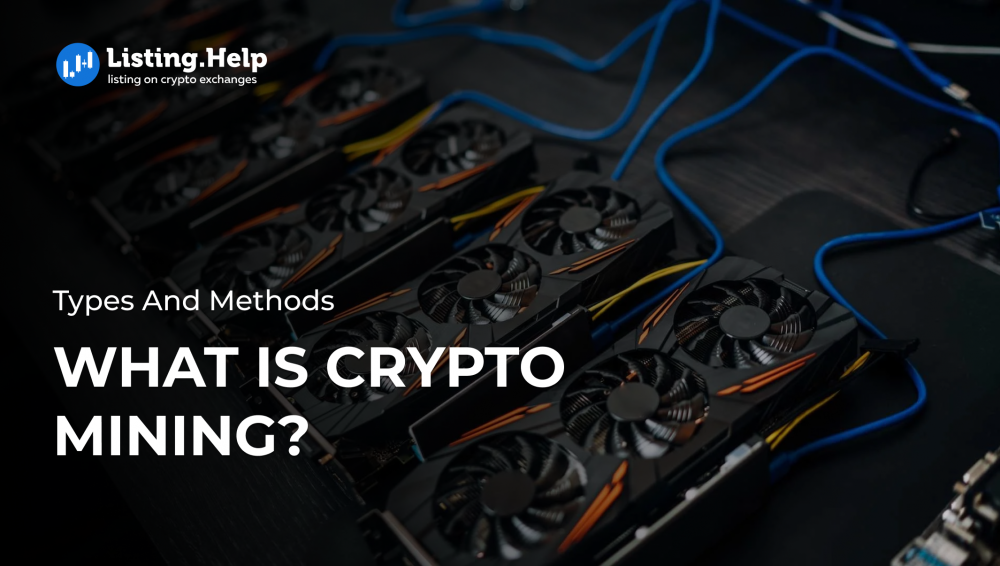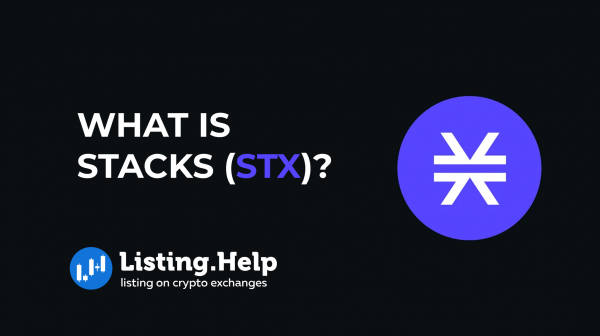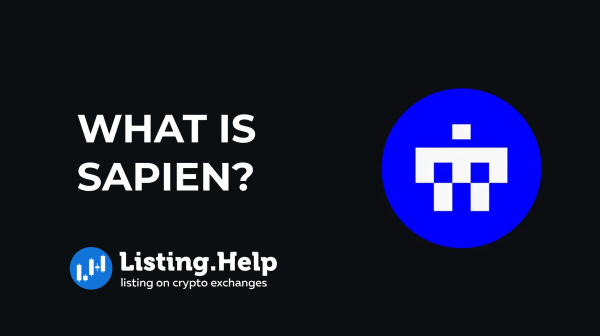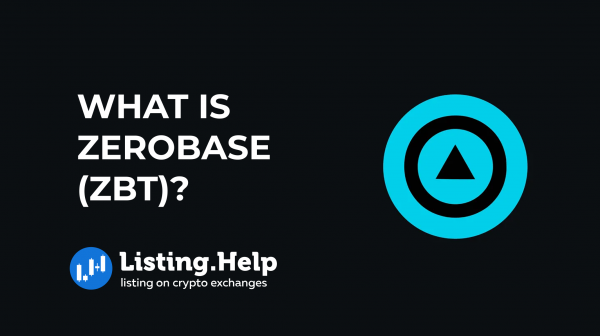What Is Crypto Mining? Cryptocurrency Mining Types and Methods.
 October 31, 2023
October 31, 2023 Updated: January 27 2025, 07:25
Updated: January 27 2025, 07:25
LEAVE A REQUEST
Launching your own token project? Our experts are ready to help with listing on exchanges, market making, marketing and other solutions
SUBMIT APPLICATIONCryptocurrency mining is a decentralized process where transactions are verified and added to the blockchain through the solution of cryptographic puzzles. This not only validates and secures transactions but also releases new coins, ensuring that coins aren’t double-spent or created arbitrarily. By replacing traditional intermediaries with a transparent, rule-based system, mining maintains the blockchain’s integrity and trust.
When cryptocurrency transactions are made, they’re grouped into ‘blocks’. Miners compete to confirm these transactions by solving intricate mathematical puzzles to find a unique hash for each block, akin to finding the right key for a sophisticated lock. This process is governed by the Proof of Work (PoW) system, a protocol confirming the miner has done the needed work to decrypt the hash.
The success of miners largely depends on the efficiency and power of their hardware. Just as a superior pickaxe improves one’s prospects during a gold rush, advanced equipment enhances a miner’s hashing speed, increasing the likelihood of unlocking a block first. In the cryptocurrency realm, success hinges on speed, power, and strategic investment in technology.
Why are cryptocurrency miners necessary?
- Transaction Verification: At its core, mining ensures the smooth operation of transactions within the blockchain. When someone initiates a cryptocurrency transaction, it doesn’t immediately get processed. Miners step in to validate these transactions. After their approval, the asset is then transferred to the buyer’s digital wallet, and in exchange, the seller can opt to receive traditional currency or even retain the cryptocurrency.
- Upholding Network Decentralization: One of the groundbreaking features of blockchain technology is decentralization. Rather than being housed on a single centralized server, transaction data is distributed across the network and stored in multiple places. Miners play a crucial role in this, as each of them holds a copy of the transaction history. This ensures transparency, security, and privacy, as there isn’t a single point of failure, and tracing the parties involved in a transaction becomes near impossible.
- Issuing New Cryptocurrencies: Miners are not just auditors; they’re also minters. As they validate and add new blocks to the blockchain, new cryptocurrency coins are introduced into circulation. This “mining reward” serves as both an incentive for miners to continue validating transactions and a mechanism for increasing the total supply of the cryptocurrency in a controlled and diminishing manner.
How Does Crypto Mining Work Step by Step?
Whenever a user conducts a transaction in the blockchain world, it doesn’t instantly get approved and recorded. Instead, the transaction details are forwarded to an awaiting area known as the memory pool. This is where miners come into play.
Miners are specialized nodes in the blockchain network tasked with an essential job: sifting through the pool of unconfirmed transactions and grouping them into what’s known as a block. Imagine a block as a ledger’s sheet where several transaction records are compiled.
However, simply compiling these transactions into a block isn’t enough. For this block to be accepted by the network and added to the blockchain, miners need to perform a specific task: they have to find a particular value (often referred to as a nonce) that, when hashed with the transaction data in the block, produces a hash that matches the network’s current target criteria.
Finding this value is no easy task. It’s like a cryptographic puzzle where miners have to use significant computational power to churn out countless numbers in quick succession, hoping to find the correct one. This process is known as “Proof of Work”, and it’s designed to be resource-intensive to ensure security and fairness in the network.
Once a miner successfully solves this puzzle and the block is verified by other nodes, the block is added to the blockchain. As a token of appreciation for their work, miners are rewarded with newly minted cryptocurrency and the transaction fees from the transactions in the block. This reward mechanism is how new coins are introduced into the system and how miners profit from their efforts.
Step 1: The Process of Hashing
To kick off the mining process, we pull all the unconfirmed transactions from what we refer to as the memory pool. We then run each of these transactions through what’s known as a hash function. Upon doing this, we get an output, termed a hash. This hash, comprising a specific set of numbers and letters, is the unique representation of each transaction’s entirety.
Now, a notable aspect of the mining operation is the addition of a particular transaction by the miner. This unique transaction enables the miner to award themselves the reward for mining the block. We label this as the coinbase transaction. It’s essential to understand that this specific transaction is the source of the creation of new coins. Typically, this is the inaugural transaction documented in a freshly mined block, subsequently followed by the batch of unconfirmed transactions.
Step 2: Formation of the Merkle Tree
Once we have the hashes for every transaction, we arrange these hashes to form a structure named the Merkle tree, sometimes referred to simply as a hash tree. To build this Merkle tree, we begin by pairing up the individual transaction hashes and then hashing these pairs.
This cycle of pairing and hashing continues, systematically reducing the number of hashes each time. Eventually, this iterative process yields a singular hash. This final hash is commonly known as the root hash or the Merkle root. To put it simply, this Merkle root stands as the representation of all the preceding hashes that contributed to its formation.
Step 3: Finding a valid block header (block hash)
Every block has its own distinct identifier, termed a block header. Each of these block headers has a unique hash. To construct a new block, the miner amalgamates the previous block’s hash with their current block’s root hash. This process involves adding a random value called the nonce.
During the validation process for a block, the miner has to combine the previous block’s hash, the root hash, and the nonce, running this amalgamation through a hash function. The challenge here is that the miner must iterate this process continuously until a specific hash criterion is met.
Given that the root hash and the previous block’s hash remain constant, the miner has to modify the nonce multiple times to achieve the desired hash. The resulting hash must meet a predetermined criterion set by the protocol to be deemed valid. For instance, in the Bitcoin system, this means the hash should commence with a specific number of zeroes, reflecting the mining difficulty level.
Step 4: Broadcasting the mined block
Upon deriving a valid block hash, the triumphant miner notifies the entire network by broadcasting the newly mined block. Every node in the network then reviews this block, assessing its validity. If the checks pass, these nodes will incorporate the new block into their version of the blockchain.
Once this is achieved, the once-prospective block gains the status of a confirmed block. Miners then shift their focus towards the upcoming block. Those who were unable to determine a valid hash promptly discard their proposed block and re-engage in the ongoing competition of mining the next one.
Types of Crypto Mining
Mining is a crucial component of the cryptocurrency ecosystem. As the process has evolved over time, so have the methods and equipment utilized for it. Let’s break down the classifications based on the equipment used and the number of participants.
Classification Based on Equipment:
- CPU Mining (Central Processing Units)In the early days of cryptocurrency, regular home-based CPUs sufficed for mining. However, with the increasing mining difficulty, CPU mining has become largely obsolete, especially for prominent cryptocurrencies like Bitcoin or Litecoin.
- GPU Mining (Graphics Processing Units)As Bitcoin gained traction and the computational demands grew, miners transitioned to using high-performance GPUs. While more powerful than CPUs, their efficiency wanes as mining complexities surge.
- ASIC Mining (Application-Specific Integrated Circuit)ASICs are tailor-made for specific mining algorithms, offering unmatched efficiency and performance. These outperform both CPUs and GPUs and are currently the gold standard in mining hardware.
To further enhance mining capacity, miners started developing ‘mining farms’ by clustering multiple devices. These farms, often located in spacious, well-ventilated areas, amplify mining output significantly.
Classification Based on Participation:
- Solo MiningHere, an individual utilizes their own resources for mining. The profits, comprising both the mining reward and transaction fees, belong solely to the miner. However, due to the heightened complexity in mining leading coins, solo mining is mostly reserved for newer cryptocurrencies with potential.
- Mining PoolsWith rising mining challenges, mining pools became popular. These are servers where miners aggregate their computational might. By doing so, they bolster their odds of mining a block. Though the rewards are shared based on individual contributions, it ensures steadier returns. Most pools charge a nominal fee for this collaborative service.
- Cloud MiningA hassle-free alternative where individuals lease computational power from established mining farms. This means participants needn’t fret about equipment upkeep or technical glitches; they simply pay a fee and let the farm operators handle the rest.
Mining Risks & An Alternative
- Legal Issues: Mining is banned or unregulated in various countries.
- High Costs: Significant investments are required for equipment and electricity, with no guaranteed returns.
- Unpredictable Profits: Many factors can affect potential earnings, making it hard to estimate true profitability.
Alternative – Staking: Instead of costly mining, consider staking. Simply lock up a cryptocurrency amount to support a blockchain and earn rewards. It’s more energy-efficient and has predictable returns.
Conclusion
Cryptocurrency mining, with its digital gold rushes and computational pickaxes, showcases the brilliance of human innovation. We’ve transitioned from a modest CPU to vast mining farms, revealing our capacity to adapt and optimize in this ever-evolving digital era. However, just as with historic gold rushes, there are inherent risks and challenges. As tools change, our timeless quest for discovery and prosperity remains undeterred.

For those captivated by this digital cosmos, delve deeper with us at https://listing.help/blog. It’s where curiosity meets expertise, and explorers transform into pioneers.







 December 29, 2025
December 29, 2025 








